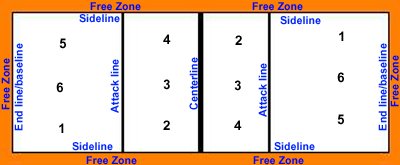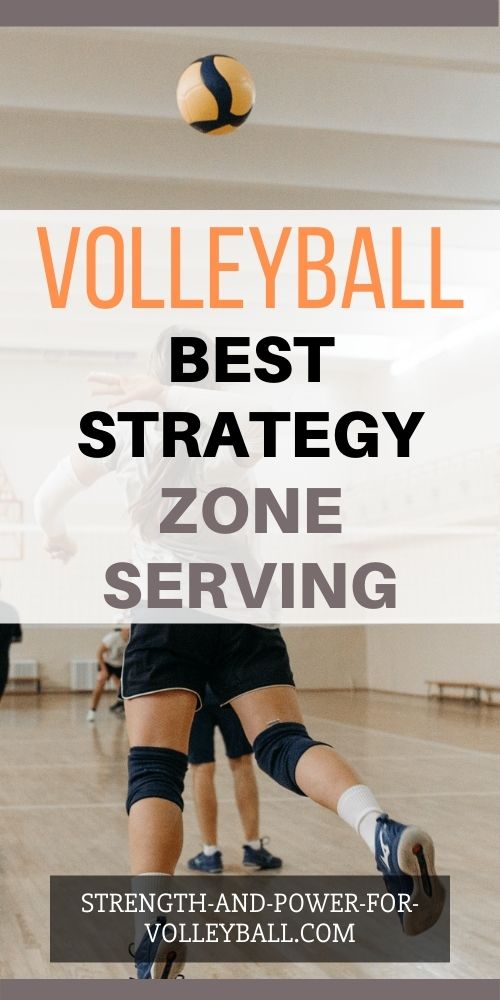Serving Zones
Strategies to Serve a Volleyball
Learning how to serve a volleyball takes a lot of practice. This is what I learned about serving zones and what I've learned this year about serving in club volleyball.
Best Strategies for Zone Serving
As a coach, signaling the server where to serve the ball can be a very effective strategy.
The zones of the court are divided up into 6 zones.
Zone 1 is right back, zone 2 is right front, zone 3 is middle front, etc.
When communicating where to serve to the server, most coaches use hand signals, signaling zones 1 through 6.
Serve a Volleyball Zone 1
Serving zone 1 is real effective at ages 13 and under. It's effective especially
at the younger ages because the setter has trouble setting the ball to the outside, when the ball is coming from zone 1.
This is something to watch for when scouting your opponent. Watch how
comfortable the setter is setting a ball coming from zone 1.
Often the setter won't turn and face the outside hitter and they'll
likely set
middle or right side instead.

Serve a Volleyball Zone 2
I like to serve zone 2 for when the opponent wants to run a slide. It's easier
to run a slide off of a pass coming from zone 4 or 5, so I prefer to serve the
left side of the court if I know for sure the opponent is wanting to run a slide
in that particular rotation.
This is the advantage of scouting your opponents hitters. Most teams have
a primary hitter in each rotation, so if you watch what they like to run in each
rotation, you can develop your serving strategy around what your opponent will most likely
try to do.
A great strategy is to take the primary hitter out of system.
Serve a Volleyball Zone 3
I like to signal zone 3 to servers that aren't comfortable with serving to zone 2 or 4,
and I want them to serve short.
Zone 3 is good if you can keep the libero from passing it. If the libero doesn't pass it
in this situation, it's very likely that a front row player will, and this will disrupt the offense.
Serve a Volleyball Zone 4
When the outside hitter is in zone 4 and is backed up to pass, this can make it
very difficult for them. First, often the outside hitters are in the game to hit and not pass. Not only could
the outside hitter have trouble passing, but it can be very difficult to first pass then go approach and hit.
Tips for serving the Outside Hitter
I have a friend that coaches women's college volleyball. He took stats on serving the outside hitter. He wanted to know
where the outside hitter hits the ball if they first pass before hitting.
He said almost all hits were
either down line, deep cross court to the corner, or deep middle. Most hits
were to deep middle or deep cross court. They never hit
sharp angle.
He said the good hitters could pound the ball down line. He thinks they
can't hit sharp angle because girls just can't physically do it. We both
agreed that if they really wanted to develop a sharp angle hit, it's
possible.
Also, most setters tend to not set the player that passes.
Serve a Volleyball Zone 5
I like serving zone 5 when the outside hitter is backed up to pass. If
you can move them backwards and make them pass, this will make it
difficult for them to get to the net to hit.
Also, it's important to mention anytime you make a front row player
pass, you've likely taken them out of the offensive play. So if your
blockers are paying attention, they can see that the front row player
that passed the ball is out of the play, and so now they can just focus
on the other two attackers.
This can be a big advantage for getting in position to block.
Serve a Volleyball Zone 6
I like to signal zone 6 when I have a server that isn't comfortable serving. Also, if a team is just flat out bad at passing deep serves, I'll likely signal zone 6. Put the ball within 8 feet of the endline and most teams will have trouble passing.
Change Serving Strategy Depending on Age Level
13 and Under
For 12 and 13 year olds, serving deep is the best strategy.
If you can put the ball within 8 feet of the endline, the passers are going to have trouble passing.
I believe this is because they are just too small to pass the deep ball
real well. Most players are so small at this age that even if they can
get
in position to pass it, they can't get the ball up to the setter. Then
you also have players specializing at this young of an age which means
the smaller players could be taking most of the passes. Even if you see
the player playing really deep in serve receive, positioned right in
front of the endline, go ahead and serve it at them because she won't
get it up to the setter. You'll almost always get an ace or at least a
free ball in this situation.
Serving the ball hard with a low trajectory, putting it near the endline...you'll at the very least get a free ball out of it.
Serving outside hitters
Serving outside hitters works well at pretty much every age level.
However, making the outside hitter pass isn't as good a strategy in 13's and 12's because
you won't get as many aces or free balls when you serve short, as you will when you serve deep.
At this age, it's easier for serve receive to keep a short serve in play, so I would focus on
serving deep.
Ages 14 to 16
For ages 14 to 16, serving the outside hitter is a really effective strategy. For one reason, I think players just aren't used to this type of serve. Most teams this young haven't developed good short serves, so players just aren't seeing it often and therefore aren't good at dealing with it. So you'll likely get a free ball from this serve at this age level, and a free ball at this age level can be a big deal. This is different than the younger ages where there ends up being free balls and down balls off of pretty much any kind of tough serve (short, deep, good floater, etc).
Ages 16 and Up
For ages over 16, serving the outside hitter
can be really effective. Especially if the outside hitter doesn't want to pass,
I would put the pressure on them by making them pass.
It's important to know who the primary hitters are in each rotation. If you can recognize who the primary hitters are, then you know what player to
take out of system.
And if you're playing a team that relies on one player to get most of
the kills, you can take advantage of this with aggressive serving.
Signaling by Instinct
After awhile, some coaches start to sense what should be signaled.
For example, sometimes, the coach doesn't know why, but for some reason they have a feeling what to signal.
As a coach, it's important to pay attention to emotions and get a sense of what would be a tough serve.
You also start to get a sense where your players are comfortable serving.
If you enjoyed these tips and would like to keep it close to you at any time, just save this pin to your Pinterest Volleyball Training Board.
Volleyball › Coaching Volleyball › Serve a Volleyball
